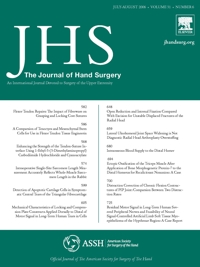
HAND & WRIST
Buddy strapping and aluminum orthoses in PIP joint hyperextension injuries
This report has been verified
by one or more authors of the
original publication.
J Hand Surg Am. 2014 Mar;39(3):449-54
121 patients (83 children and 38 adults) with a proximal interphalangeal joint hyperextension injury without fracture were randomized to treatment through either buddy strapping with the neighbour finger or an aluminum orthosis which immobilized the joint at 15 degrees flexion, with each applied for one week. The purpose was to determine whether there was a difference in range of motion, edema, pain, or strength between the two treatment options. The results indicated that motion restoration and resolution of edema was significantly better with buddy strapping within the first 2 weeks, and more patients were pain-free at the 2-week follow-up. From the third week of follow-up and thereafter (up to 1 year after injury), no significant differences were observed between groups. Both treatments were associated with similarly good outcome at 1 year. Better results were observed in children, and in those with less severe injuries, regardless of the treatment allocation.
Unlock the full ACE Report
You have access to {0} free articles per month.Click below to unlock and view this {1}
Unlock NowCritical appraisals of the latest, high-impact randomized controlled trials and systematic reviews in orthopaedics
Access to OrthoEvidence podcast content, including collaborations with the Journal of Bone and Joint Surgery, interviews with internationally recognized surgeons, and roundtable discussions on orthopaedic news and topics
Subscription to The Pulse, a twice-weekly evidence-based newsletter designed to help you make better clinical decisions
Exclusive access to original content articles, including in-house systematic reviews, and articles on health research methods and hot orthopaedic topics
Or upgrade today and gain access to all OrthoEvidence content for just $1.99 per week.
Already have an account? Log in


Subscribe to "The Pulse"
Evidence-Based Orthopaedics direct to your inbox.
{0} of {1} free articles
Become an OrthoEvidence Premium Member. Expand your perspective with high-quality evidence.
Upgrade Now













































































